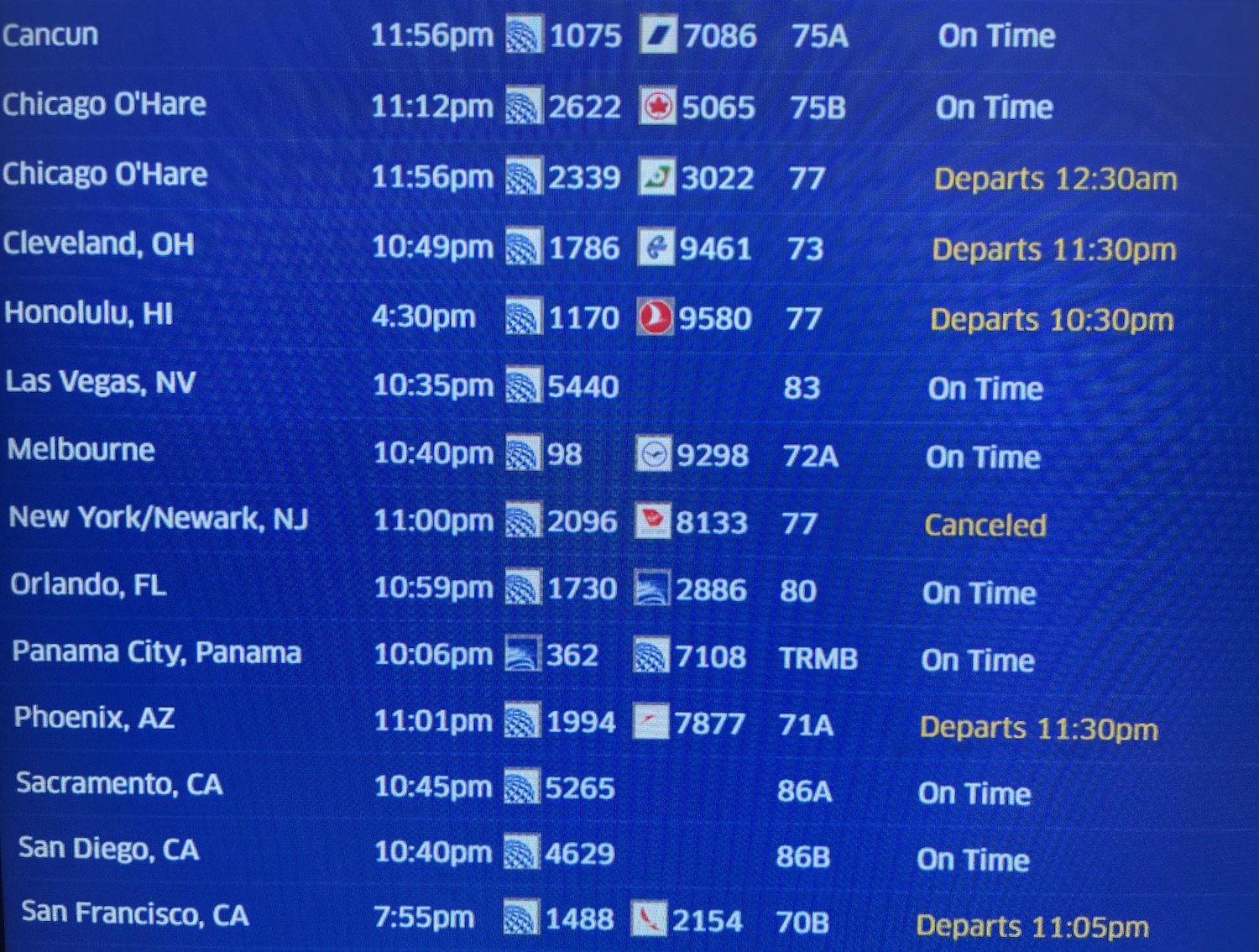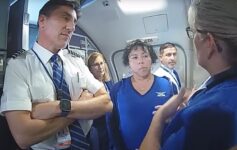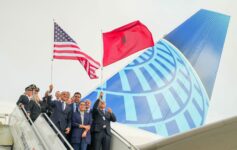
Another story on United Airlines today thanks to a long note to staff that CEO Scott Kirby just sent out. Kirby has put together a timeline seeking to explain what happened and exactly why United suffered an operational meltdown this week. It is helpful to examine and yet the takeaways are unsettling.
Scott Kirby Explains Why United Airlines Faced Operational Meltdown This Week
A very detailed note was just posted to United’s internal website and shared with Live And Let’s Fly.
In short, Kirby traces the issue back to bad weather at Newark Airport (EWR) that limited flight operations, causing a domino effect of disruption across the system. Let’s take a look at the specifics:
While there was weather around the system, the truly unprecedented severe weather was focused at EWR. We dealt with severe restrictions on flight operations starting Saturday that lasted through Tuesday.
- EWR has 40 departures per hour scheduled;
- On June 25, we were limited to less than 20 departures per hour for four hours;
- On June 26, we were limited to less than 20 departures per hour for nine hours;
- And on June 27, we were limited to less than 20 departures per hour for six hours
That means the total number of aircraft that could depart EWR was reduced between 60-75% for an average of 6 to 8 hours each day. Airlines, including United, simply aren’t designed to have their largest hub have its capacity severely limited for four straight days and still operate successfully.
I shared my thoughts earlier this week about the FAA’s need to staff up. Since then, I have personally had incredibly thoughtful and constructive conversations with the FAA and Secretary Buttigieg. The current FAA leadership team inherited these challenges, and to their credit, they have been public that they’re thousands of controllers short — and the NY/NJ airspace, in particular, is understaffed. N90, which manages all the New York and EWR airports, is also probably the most technically challenging job anywhere in the world in aviation which means that experience also makes a difference.
But here’s how those staffing issues – combined with days of rolling thunderstorms – really impacted United:
Thunderstorms moving west to east typically hit EWR first when they roll through the NYC area, and that closes the two departure fixes that aircraft use to travel west out of EWR. Pre-pandemic, when that happened, some of our flights still had a chance to depart to the north and then fly west over Canadian airspace to get where they needed to go. Sure, in those cases the flights were longer, and we took delays, but we didn’t have to cancel. But today, Canada’s air traffic control is short staffed too, so they’ve closed those routes. So now, we often get reduced to a single digit (and often zero) departures per hour. And that’s basically what happened between June 24-27. The reality is that EWR simply can’t function under thunderstorm conditions unless there are departure routes to the west and that’s one of the biggest takeaways that the FAA is diligently working on with us and Canada.
And after the storms ended, it took us a few more days to recover. The level of disruption we experienced left our aircraft and crews scattered around the country and out of position. There are, however, definitely things we can learn to do better in the future to recover faster.
I found this explanation very helpful. And yet this is the reality and that Kirby himself has been warning about for months and therefore while I do think Kirby is correct that this situation was not United’s fault to begin with, a schedule from Newark that remains to ambitious doomed operations and made a bad situation much worse.
Scott Kirby Proposes Five Solutions To Avoid Future Meltdowns
Kirby next proposes five solutions he hopes will reduce repeat occurrences of this week:
-
More improvements to our crew technology. Our crew systems are among the best in the world, but they’re simply not designed for what we went through this past week. We had very long hold times, and while we already have a lot of online capability, we still have far too much manual work – that’s not acceptable. Our goal in the future is that you won’t need to call crew scheduling and can self-serve and do everything online via an app that’s just as good as our customer-facing app. We’re committed to making that a top priority.
-
Partnership with the FAA is critical. Like I said, the FAA is engaged on this, and they’ve taken significant steps in the short term like bringing in more senior managers on weekends and working with NATCA to cover for any vacation/sick calls. Plus, we both have significantly increased the day-to-day communication between the FAA and United, with a focus on EWR.
-
Support FAA efforts to find long term solutions. First and foremost, that means continuing to advocate for passage of the bipartisan FAA reauthorization bill that gets them the right staffing, invests in infrastructure and technology modernization, and gives the FAA more certainty in investing so that they can accomplish long term projects. We are also supportive of the FAA’s initiative to move EWR ATC from N90 to PHL which we and the FAA believe will help with operations at all three large NY area airports.
-
We need to balance departures and arrivals at EWR. When departure routes are shut down (because of thunderstorms to the west), arriving aircraft keep landing and because aircraft can’t depart to create space for them, they fill up the taxi ways because they are stuck in a long line.If just one aircraft in that line is waiting to depart, then all the aircraft behind them are stuck and so, the whole conga line is trapped. The traditional way the FAA manages capacity constraints is arrival rates. At most airports, this is fine since there’s multiple taxiways, gates, and other places to park aircraft.But they’ve agreed with us to work on balancing arrivals and departures at EWR, in particular.
-
EWR is the best international gateway that exists anywhere in the country. But it’s also the most operationally difficult airport in the country. The Port Authority is working with us to get more gates (which are critical to avoid gridlock on the taxiways), but we are going to have to further change/reduce our schedule to give ourselves even more spare gates and buffer – especially during thunderstorm season.
Numbers one and five are what United has control over and reducing flight schedules and accelerating technology to replace the manual needs for crews to call the help desk is essential.
Number four has interesting ramifications: we might see more proactive cancellations or diversions in poor weather events precisely because landing at Newark exacerbates a bottleneck, leading to more delays and cancellations.
CONCLUSION
The private jet issue has been a distraction not only in undermining Kirby’s leadership, but in taking attention away from the operational meltdown itself. The timeline makes sense and while it is not reasonable to blame United for the weather or for FAA staffing shortages, it now becomes incumbent upon United to reduce schedules out of Newark in order to avoid repeat occurrences of this week. There is no other way: Kirby himself said, “The reality is that EWR simply can’t function under thunderstorm conditions unless there are departure routes to the west.” Until such departure routes exist (and even with a reduced schedule), Newark is going to be a mess this summer when the inevitable summer storms arrive.




I wondered how Kirby would find a way to blame someone – anyone else really – for his shortcomings. Question answered.
He sure seems to have changed his tone with regards to the FAA.
His tone and his tune, to be more accurate.
Mayor Pete wasn’t happy.
Can you blame him? Kirby was desperately trying to assign blame to anyone but himself and the FAA looked like a convenient target. I wouldn’t take that without a fight either.
Secretary. He no longer works in South Bend.
He’ll still be Mayor Pete even when he’s President B.
Mayor Buttplug, ironically mayor of one of the crappiest towns in America
Hilarious that he thinks repeatedly coming up with niche ways to blame the FAA is a winning argument. The writing was on the wall, Delta and American responded accordingly, and United didn’t. That’s just bad planning by United.
American carries about half the pax in NYC as delta and UA, and delta is about evenly split at LGA and JFK, with very little at EWR. UA is almost all at EWR so they are in a much different situation than the other 2.
The suggestion that American or Delta faced an equivalent challenge in this particular event is ridiculous. Both airlines have smaller NYC hubs than United and neither has a large presence at the most-impacted airport.
If the weather is west of EWR, the flight paths into/out of JFK and LGA also may have made those airports significantly less impacted. JFK keeps inbound aircraft coming from the west high over NYC to avoid conflicting with LGA/EWR traffic and then has them descend to a final approach altitude over the Atlantic. Aircraft into/out of LGA overfly parts the city itself, such as the approach to runway 22 over the Hudson.
Aircraft into and out of EWR are forced to stay inland and west of the city to avoid low-flying LGA and JFK traffic. If you look at arrivals from the North Atlantic bound for JFK versus EWR the EWR arrivals take a much more inland route even hundreds of miles away. So you have a situation where weather is directly in the flight paths of flights departing from and arriving to EWR, and those flights typically pass over those areas at lower altitudes than JFK/LGA traffic.
United absolutely needs to figure out how to mitigate the structural challenges it faces at EWR – things are always going to be operationally tight when you have an airport with limited room for terminal expansion, only 2 runways in some of the busiest airspace of the world, and robust demand for high frequency on routes. They need to be able to isolate Newark from impacting the rest of the network on these days. Kirby also has work to do in fixing the relationship with crews, and he really dug himself in a hole with the poor optics of the private jet. Now that’s going to be what lingers in the minds of the public, regulators, and employees instead of actually finding a solution to this problem.
Perhaps one of the best comments I have read in years. Have no clue who you are but you have a knack for the nuances and explaining them well.
Bottom line is, that’s what Kirby should have done, explain them so succintly. Instead of blanket blaming the FAA. Further, it was his job to anticipate exactly this scenario, which I believe the DOT warned them of earlier this year as to the summer schedule, and make the adjustments needed. Instead, it seems to me, Kirby rolled the dice. And then ran home on a private jet to escape the backlash.
What’s new at EWR is the extreme low staffing at ATC – UA needs to dial back a bit until that’s addressed.
It’s operated and grown as a modestly less reliable airport than JFK/LGA a few storms a year .
A new terminal just opened with more gates to come.
SFO is a truly hamstrung airport whenever that market recovers from the tech bust with the parallel runways and a duct tape staggered landing protocol
Why no mention that he hasn’t returned to Continentals hub and spoke system of flights?
If there’s weather in 1 region, it doesn’t take down your entire airline…
Good news is that their meltdown (btw. glad you finally officially called it as such lol) is just about over, if FlightAware is any indication
Bad news is that, IMO, other airlines with fortress hubs (like DL in ATL, AA in DFW etc, or heck, UA again in IAH) is one bad weather away from experiencing the same thing, and I’m not really sure, at least in DL’s case, if they’re any more prepared than UA.
As far as their IRROPS go all US airlines all kinda suck right now to varying degrees.
I’m just curious why UA continues to go all in on EWR, even for connecting traffic. I completely understand the unique nature of the NY metropolitan area (I lived there for several years) in terms of a very large population and high volume of business travel, so those lucrative routes will always be there. But what I don’t understand is why they’re purposely putting so much feed through EWR when they could be utilizing IAD. How many daily flights do you really need to LHR? How much of that is connecting traffic from small markets? That’s the traffic that I feel could benefit by bolstering IAD.
I do think United is making much great effort to push connecting traffic via IAD instead of EWR. I notice for example when I buy LAX to PIT trips I can route through IAD/ORD/DEN/IAH, but not EWR.
Continental then United had a smaller hub in Cleveland to take this exact pressure off the hubs at EWR and ORD. They have been paying debt service for years on Terminal D which was constructed for that purpose, but was closed. I’m sure it’s more profitable to not maintain that smaller hub, but it’s the passengers who suffer, not the airline, when things go astray because the redundancy in the system has been removed.
I’m not sure DL had a better week out of NYC, in fact higher percentage delayed
That said this kind of detail is exactly what needed to be outlined and yes the schedule was too ambitious
higher percentage delayed on Monday
Kirby may have partially covered his tracks with his PAX via the 30kMiles and the public with the above mea culpa narrative.
However, he’ll need to pull another rabbit out of his hat to placate the rank & file employees.
If not, he won’t get their support in the next UA calamity, and his job prospects won’t look too good in Willis Tower.
This rings a bit hollow. Why? Issue number one has been ongoing probably for at least a year. Cannot get through to the crew desk, difficult to get through to the hotel desk so crews are left with their thumbs up their noses. Worse yet waiting around has been part of your layover not anymore it’s not.
It’s just more time for which crews are not compensated and it’s not their fault.
Why hasn’t it been fixed she’s out at least why haven’t there been improvements?? I will tell you why, it’s not a priority plane and simple.
This is just an exercise in putting out fires. Right now Scott’s pants are on fire!!!
@ Mtthew — #6 Fire Kirby
So, for those of us keeping score at home, according to Kirby it’s now: global warming’s fault, Trump’s fault, and Canada’s fault. To be sure, training additional ATC operators in the U.S. and Canada will help alleviate some of the issues. However, that will take time (years?). In the meantime, UA will have to be more conservative with the number of flights at EWR and, if things get really bad, maybe start looking for another hub in the area? Perhaps we got Kirby all wrong and, instead, he was scouting out the viability of Teterboro Airport as a new area hub? 🙂
LOL on Teterboro.
Maybe united needs more ‘diversity’ in leadership? Scotty is all for it
“EWR is the best international gateway that exists anywhere in the country.”
Really? Why? What makes it the best?
Am i the only one who quickly rules out any itinerary that includes connecting at EWR?
I never expect ANYTHING from ANY airline (and especially NOT the Food) besides expecting the eventual arrival at the destination of my trip. Mind you, I was surprised that I just got an email today from UNITED saying that we will all get 50,000 FREE bonus miles for having put up with the delays of last week (which I really didn’t put up with except for having to rebook another flight which was better actually better for me).
i.e. 30,000 free miles
I love reading the well spoken words from people that have absolutely no clue how ATC or Airlines function. The one comment from SEASFO is the only comment that matters IMHO. This person is most likely an Air Traffic Controller on the east coast, or possibly a pilot for a major airline, but most likely is a Dispatcher for one of the major airlines. Dispatchers, more than anyone, have the overall big picture.
Just because you intensely dislike someone or are in heated contract negotiations doesn’t make the meltdown all their fault. The Hub and Spoke system of flying that almost all the major airlines use has alot to do with how well or how poorly an airport functions. Especially in bad weather. The east coast is unique in that it has 8 large airports with significant volume. IAD DCA BWI PHL EWR LGA JFK BOS. All it takes is 1 thunderstorm cell in the wrong spot to shut down arrivals or departures in a specific direction. If that is arrivals it puts planes into holding patterns clogging the airspace and eventually (quickly) causing a workload issue for the ATC person. If it’s departures then the runways/taxiways start backing up. If the direction stopped has any volume the snowball effect can overwhelm an airport.
EWR is a huge hub for United, if Delta had had this meltdown we would be talking about their huge hub at LGA.
The delay program Mr. Kirby is talking about is called a Ground Delay Program or GDP. ATC sets an arrival rate for the airport and airlines take that delay on the ground at the departure airport rather than use holding patterns and burning expensive fuel and still have numerous diversions.
Bottom line is that it is all very complicated and simple statements that it’s “all his fault” are pure poppycock.
The airlines control their schedules and should get a fair amount of blame.
Like butter wouldn’t melt in his mouth. This is Kirby’s mess: the Buck stops here. What a tool. Modern CEOs take massive salaries, yet whine like spoiled children when something they did has consequences.
Don’t like the staffing at the FAA? How about diverting some of those lobbying funds into paid taxes?